How to Nab Leads & Convert Visitors w/ Spider Web Marketing

Nature is a fantastic source of inspiration.
And if you want to learn how to build a strong business with a steady flow of clients coming in to your door, there’s no better teacher than mother nature.
For instance, look at the web-building techniques of the spider.
Taking some inspiration from this, you can make it one of your growth strategies to improve your blog’s lead generation rate.
I call it “The Spider Web Marketing Strategy.”
And in 4 steps, you can start converting more visitors with your marketing funnel by applying this on your blog and in your content marketing in general.
Here’s what you’ll get in this article:
- What spiders have in common with this content marketing strategy.
- Why a little SEO research before sitting down to write will dramatically help your Google search rankings.
- How you can turn every page on your site into a landing page (and therefore, a full-time salesman).
- Why publishing frequently and consistently (without skimping on quality) is key to converting leads.
- How to identify and strengthen the pages of your blog (or sales funnel) that are most effective.
Sound good? All right, let’s learn more about this strategy, how it’s worked for us growing our traffic and leads, and how you use it to start boosting conversions with it right now.
In a rush? Want to download this article as a PDF so you can easily take action on it later? Click here to download this article as a PDF guide.

Think of Your Website Like a Spider Web
For example, take a quick look at the video below. It is truly fascinating (even if you hate spiders).

Now, if you’ll notice, this spider (and all spiders, in fact) are incredibly strategic about how they construct their web.
First, it creates an initial set of “load-bearing” strands and wide circular rings that serve as the basic framework for the rest of the structure.
It will then maneuver around the circular frame (which is divided into “columns,” or better described as slices in a pie chart).
And then turn the relatively wide open slices that point towards the center into tiny “ladders” with many “rungs.”
Again, I encourage you to check out the video to see what I mean.
Spiders do this because by increasing the surface area covered by the webbed lining AND making the openings between each “rung” smaller, it increases the rate at which the spider is likely to capture a meal (i.e. a fly or some other kind of insect).
In the end, a well-constructed web means more meals for the spider.
Okay, But How Does This Apply to Your Website?
Well, your website needs to be thought of in the same way.
- Similar to how the spider makes his web, you should create an interconnected “web” of blog articles and web pages that are educational and relevant to your core business. SEO in particular is useful for this.
- Just as the spider works to grow the surface area of his web, you should continuously create new content to expand your reach. Creating more quality content increases the likelihood that people in your target market will discover you organically in Google search.
- And see the way the spider shrinks the spaces between each opening in his web to maximize the chance of catching a meal? Each of your web pages must be continuously studied, updated and strengthened so as to nudge new visitors towards an email opt-in conversion.
The following 4-step formula goes into greater detail on the exact tactics involved here.
Step #1 – Plan Your SEO to Get Long-Term Organic Traffic From Each Piece of Content You Create
Now that you understand the basic idea (continuously creating an interconnected web of content that attracts and converts), it’s time to understand the organic traffic attraction part of the equation.
See, when you create new content, promotion is a necessary part of getting the amount of traffic that you’re looking for.
Here’s how your ideal content promotion cycle should look according to Orbit Media.

There are plenty of ways to promote your content.
But a lot of those methods take time. And time is money.
Instead, the best way to make sure your content is attracting long-term, residual traffic is by ensuring it’s getting found by search engines.
In fact, this principle is the basis of a successful content marketing strategy.
That’s because when your content is being found organically, you don’t have to pay to get people to see it.
Instead, the quality of your content does all the hard work for you.
Here’s a nice visualization of how the ROI of content marketing increases over time and, ultimately, outpaces paid promotion.
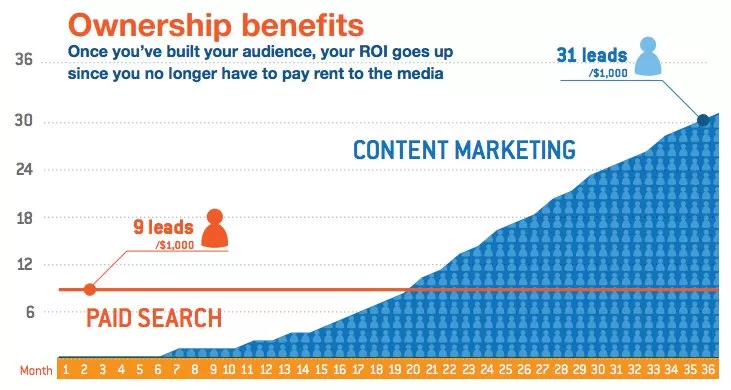
With that in mind, one step that should always be a part of your content creation process is SEO research.
Whenever you’re creating any sort of content (whether it’s a landing page, a blog post, or anything else on your website), be sure to do plenty of research on what people are searching for.
For example, before we create a post on our blog, we task our keyword specialists with nailing down high-volume, low-traffic keywords that we can hit to increase our rankings on search engine results pages (SERPs for short).
And taking the time to ensure you’re ranking well pays off too.
After analyzing 5 million Google search results, Backlinko found that the position your content ranks as is a huge predictor of its clickthrough rate.
How huge of a predictor, you ask?
Have a look at what they found.

According to their data…
- The #1 organic result is 10X more likely to receive a click compared to a page in the #10 spot.
- Moving up just 1 spot in the search results can increase CTR by 30.8%.
Plus, including the right keywords in strategic places like your URL can increase CTR by a whopping 45% too.
The main message here is the more you incorporate effective SEO strategies into your content creation, the more likely you’ll be to rank.
Think of it like closing off spaces between each strand of web. The more SEO friendly your content is, the more likely you’ll be to catch someone searching for content.
Tips for Improving Your SEO
Now, saying you want to improve your SEO is one thing. Actually doing it is something else entirely.
But to make things a little easier, here are some basic tips to help you get started (but there are plenty more too).
- Familiarize Yourself With the Basic Tools – Google’s Keyword Planner, Google Trends, Google Suggest, Google Search (so you can get an idea of what words are ranking), and Google Analytics are all great for researching keywords.
- Craft Headers Wisely – Strategically place keywords you’re hoping to rank for within your headers. Of course, avoid keyword stuffing and always keep your reader’s interests first.
- Fill Out Metadata – Meta descriptions, meta titles, header tags, image alt text, and more are all necessary for making it easier for Google and other search engines to rank you higher on their pages.
Step #2 – Let Each Page Do the Work for You By Treating Each Page on Your Site Like a Landing Page
This one is a real gamechanger. I know when I came to this realization, it fundamentally altered the way I viewed every page on our website.
Ready?
Every page on your website is a landing page.
I’ll say that again.
Every page on your website is a landing page.
If you are serious about growing your email list, getting more conversions, or just plain ramping up your business growth, this is an invaluable lesson to learn.
To take advantage of that fact, you need to understand that every page might be the first and last opportunity you’ll ever get to capture someone’s contact info (which will let you nurture them into a sale over time).
Or if your goal is immediate sales (usually not the case for high-ticket products), then you need to realize that this might be the last chance you get someone to buy what it is you’re selling.
So, here’s what taking advantage of this revelation looks like.
Growbo’s Blog: An Example to Copy
Take the way we set up Growbo’s blog as inspiration.
Each page on our blog actually has a whopping 12 points where we make it possible for visitors to convert and opt in to our newsletter.
Here’s where those opt-in points are.
First, there are the obvious ones.
Like the sidebar lead magnet opt-in for our free guide.

Then there’s the newsletter sign-up box located not too far below that.

And then there’s the exit intent pop-up box that, well, pops up when the site detects your mouse heading towards the “back” or “exit” button.
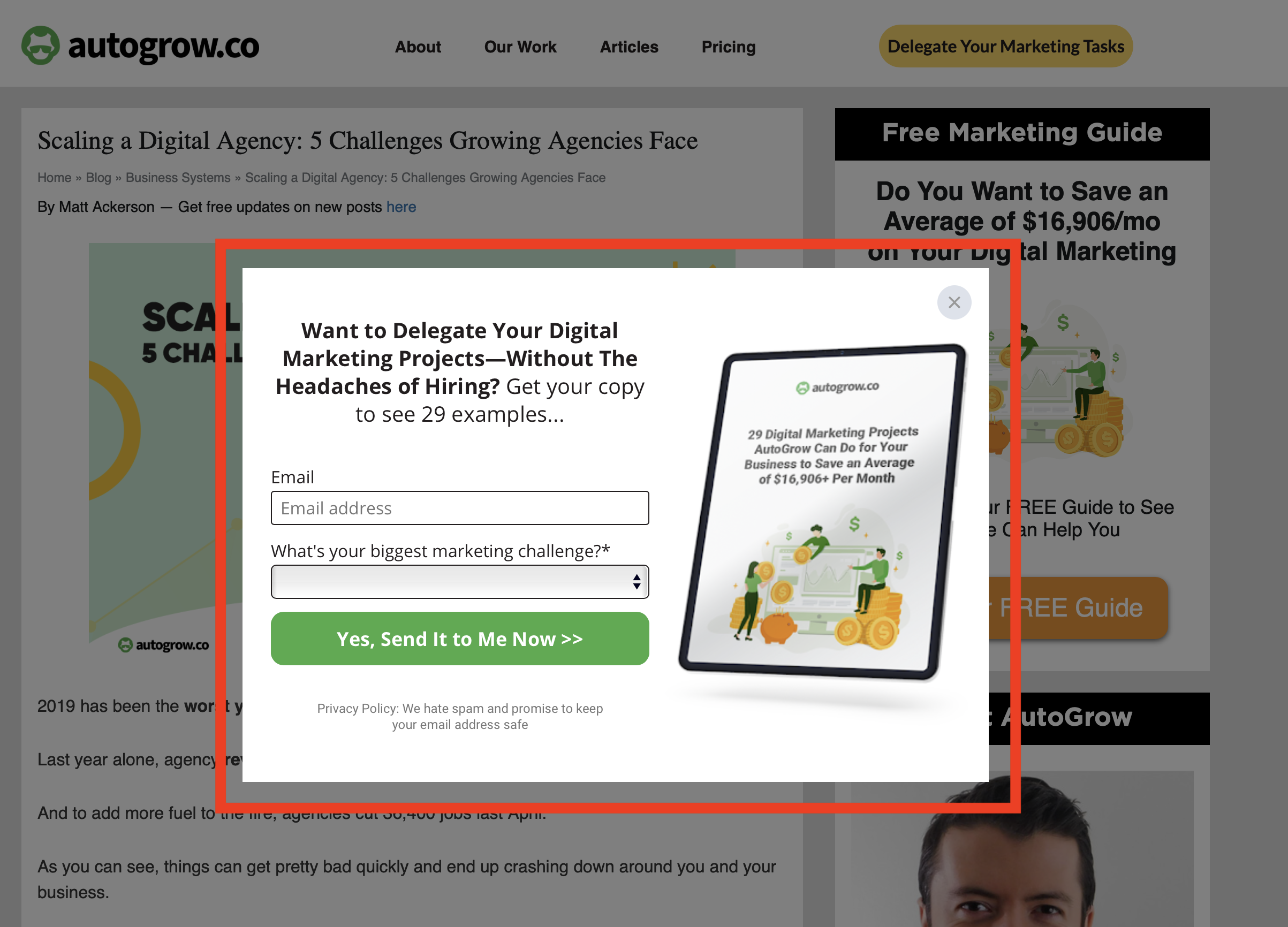
A quick word on exit pop-ups: this type of lead magnet pop-up offer is without a doubt one of the most effective out there.
Research from iPaper actually found that the top 10% of exit intent pop-ups had a conversion rate of 28%.
Not bad, right?
The trick is you have to implement this tactic strategically.
Jump right into the pain points of your visitors and be quick to offer a solution. Coupons, discounts, and freebies like downloadable guides are great for pop-ups.
Now, back to our opt-in points.
At the very top of the page, you’ll also notice that right next to the byline, there’s a subtle opt-in that, despite its size, does actually work.
See?

Once you scroll further down, you’ll also notice another CTA that’s emphasized by a yellow box.

While the other opt-in sections offer updates on new posts, subscription to the newsletter, or a free guide, this one’s a little different.
Instead, this opt-in actually offers a content upgrade where visitors can actually download the article in PDF form.
It’s perfect if a visitor is running out the door and doesn’t want to forget about reading your valuable content.
There’s also another content upgrade right before the end of the article too.

And if you scroll down, you’ll also see that there’s a sticky widget for the lead magnet that follows you down the page.

When you get to the bottom, there’s also a comments section.
Now, this tactic is actually one of my favorites because it’s so simple and so underutilized.
We’ve made it a requirement to enter your email address before you can submit a comment.
See?

Then there’s the footer of our blog.
This section has a double CTA—one redirecting users to our homepage where they can learn more about our monthly service.
And the other is to download our guide to how we can save our clients $16,906+ on their digital marketing.

And finally, there’s also a scrolling banner that follows you down the page…

The “We’re Hiring” link at the bottom…

The “Read Previous Post” side pop-up…

And, of course, we’d be fools if we didn’t include social share buttons (because social is super important for your digital marketing)...

Whew.
That’s 12 strategies for increasing opt-ins on your page by my count.
Now, that all might seem exhaustive, but the truth of the matter is it’s all pretty tame when it comes to how it affects the user experience.
None of the tactics are particularly jarring or off-putting and they all flow seamlessly into the page, which is helpful in keeping your visitors from clicking away.
But on top of that, one of the main takeaways here is that having so many different options for opting in follows the Law of Range (one of the 11 Laws of Sales Funnel Physics).
The more options of incentives that you can give to your visitors to opt-in, the higher your opt-ins are going to be.
It’s just one of the lessons I teach in my 6-Figure Sales Funnel Training program.
So if you’re interested in learning more, I’d encourage you to take just a second to learn more about it now.

Step #3 – Develop Consistently Fresh Content & Boost Frequency When You Can
Alright.
Now that we’ve made sure our webs catch as many conversions as possible by 1) increasing organic traffic with SEO and 2) by treating each page as a landing page, it’s time to expand our webs.
And the best way to do that is by creating more quality content consistently.
In case you didn’t notice, there are two main points being emphasized there (“more” and “consistently”).
First off, the more content you have, the more traffic you’re going to bring in.
Pretty intuitive, right?
But even still, let’s take a look at some numbers to see just how drastically publishing more can increase your traffic (and grow your web).
Hubspot’s State of Marketing report, for example, found an incredibly strong correlation between publishing frequency and traffic.

On top of that, blog post frequency also ties neatly in with customer acquisition too.
Check it out.
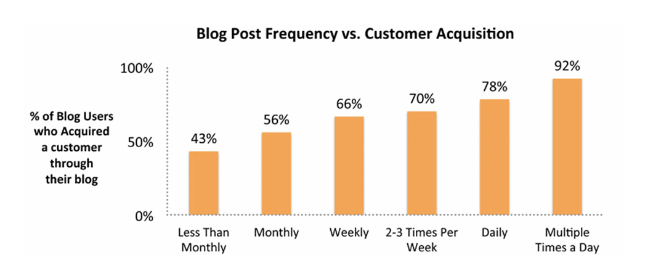
It’s no wonder why bloggers report strong results for publishing at least daily according to Orbit Media.

But it’s not just blog posting either.
In general, the more content you have, the more people will visit your site.
For instance, a study from HubSpot that surveyed more than 7,000 businesses found that lead generation rose with the more landing pages a business had.
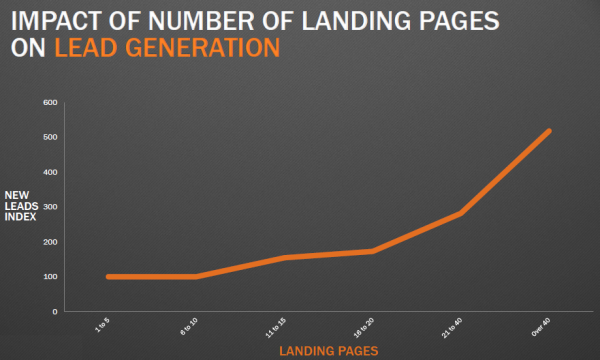
The correlation was so clear that they predicted that increasing the number of landing pages on a site from 1-10 to 10-15 can actually lead to a 55% increase in the number of leads.
Okay, so quantity of content obviously matters here.
What about the frequency?
Well, it turns out that posting consistently is pretty important too.
While the statistics aren’t as numerous as when it comes to frequency, I’ve talked about how important it is to publish consistently.
For instance, HubSpot’s State of Marketing Report (again) found that 82% of marketers who blog consistently see positive ROI from inbound links and increased rankings in search engines.
Publishing consistently is one of the best ways to show your readers that you care about putting out good content. And you care about the fact that your readers are looking forward to reading that content.
And when you communicate that, they’re going to be much more likely to see you as an authority in your field.
But There’s a Catch: Quality Counts Too!
The headline pretty much sums it up.
You need to continue to put out quality content, not just frequent content.
If, for instance, you sacrifice the depth of research, actionable tips, and informed insights you provide in your content for more weekly posts, you’re bound to see a drop in your traffic and conversions.
Orbit Media again provides some pretty telling stats on this point.
For example, they found that posts with more than 2,000 words were associated with stronger results than shorter ones.
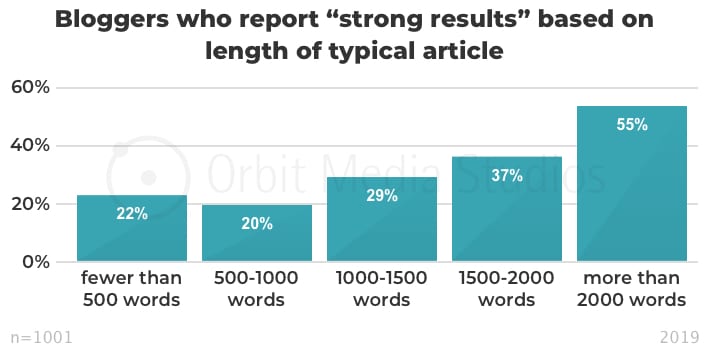
Now, I know that length isn’t everything and it certainly isn’t the only indicator of the quality of the content.
That being said, Orbit found another valuable insight too.
It turns out that time invested (a solid indicator of quality) leads to better results too.

The takeaway here is that the higher quality your content is, the more likely it’s going to get the results you’re after: conversions.
So, increase your content publishing frequency. But never let it hurt your publishing consistency or your quality.
Step #4 – Identify High-Performing Pages & Beef Them Up!
After building a good marketing habit around creating great content and you have some traffic flowing into your website, you’re going to want to start looking back regularly at your pageviews, email opt-ins, and social share data to see which articles are most popular.
Because the next step in the Spider Web Technique is to strengthen pieces of content that are performing especially well on your website now.
Think of this like strengthening the structurally supported strands on your web.
To give you an example of what this technique looks like, our blog gets a good amount of traffic (especially now since we increased our posting frequency to 4 times a week).
But even still, an astounding 40% of that traffic comes from just 3 articles.
See?

Now, a solid portion of that traffic comes from us linking internally to them (a great free strategy for increasing your website traffic).
But yet, the majority of that traffic is from organic search.
When we first noticed this trend, we started the habit of going back to examine the on-page SEO factors that might affect how and where these pages would be listed in search.
And going back to the originals was a wakeup call. Because at the time they were first published, they were high-quality articles.
A fair amount of research, some pretty powerful insights—good stuff.
But now, having improved our own content creation skills, there was clearly a lot we could do to make them better.
So, that’s exactly what we did.
In order to strengthen the content that’s already bringing in loads of traffic, we went back and beefed up those articles.
And it’s done wonders for our traffic.
For example, with our best sales funnel examples article, we were seeing okay traffic.
But after we made some tweaks (updating the examples, adding more research, adding more pictures, etc.) we were able to actually skyrocket our traffic from it.
See?

In fact, month over month, it now brings in twice as many visitors as it did before because of the changes we’ve made.
Other people are seeing the benefits of doing the same thing to their own blog too.
For instance, David Schneider of Ninja Outreach improved his traffic by 40% by focusing on revamping old posts.

And when you implement the same strategy for your pages, I’m sure you’re going to see some pretty powerful traffic gains as a result.
Tips for Beefing Up Old Content
- Add more research
- Include more examples
- Provide more actionable tips
- Link to more tools
- Include more pictures
- Vary up the structure with more bullet points and shorter paragraphs
- Separate sections with more headers
- Be sure to fill out SEO necessities like metadata
Conclusion
Download the “How to Nab Leads & Convert Visitors w/ Spider Web Marketing” so you won’t forget to take action on it later. Click here to download it now.
Nature has many lessons for the savvy entrepreneur, small business owner, or marketer—if you just know where to look.
The spider, a simple creature that has been around for much longer than the human race, has had time to perfect its instincts around how to capture a meal.
In business our “meal” is website traffic or a conversion on a form.
And if you learn from the strategies of the spider, you can boost your conversions, grow your traffic, and scale your business.
To review:
- Plan for long-term traffic by understanding what people are searching for; incorporate what you learn into the construction of your content.
- Treat every page of your website like a landing page.
- Publish new (quality) content regularly for an extra boost in search traffic.
- When you’re done, go back regularly to optimize past pages for even more traffic by improving the on-page SEO, content, or conversion related elements.
Now, what kinds of results have you seen from implementing The Spider Web Marketing Technique? Do you have any other tips for our readers for improving traffic?
Keep Growin’, stay focused.














